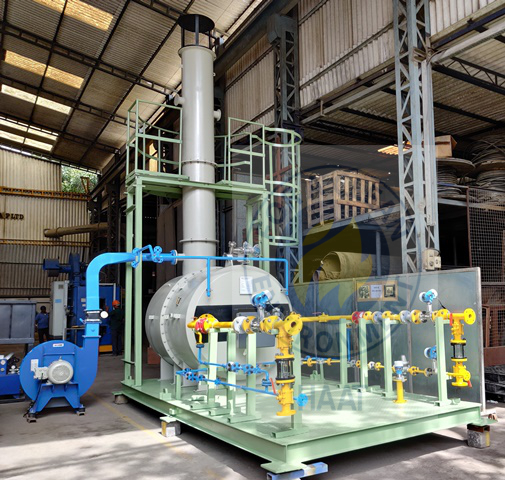
Direct Fired Thermal Oxidisers (DFTO)
Haat has Thermal Oxidisers in its range, both Regenerative (RTO) and Direct Fired (DFTO). In this blog we are going to talk about the DFTO.
As the name suggests, a DFTO, unlike an RTO, handles gas with pollutants such as VOCs directly without letting it go through a battery of filters. Thermal oxidizers are used to get rid of hazardous air pollutants (HAPs) and Volatile Organic Compounds (VOCs) from process air streams. These pollutants are generally hydrocarbon based and when destroyed by thermal combustion, they are oxidized to form CO2 and H2O.
For thermal oxidation in a direct fired thermal oxidizer, the process stream with waste gases is introduced into the chamber through a burner or through a separate inlet. Sufficient residence time is provided in the chamber to get the desired Destruction Removal Efficiency (DRE) of the VOCs. Most direct-fired thermal oxidizers operate at temperature levels between 900 to 1200°C with additional combustion air.
Three main factors in designing effective thermal oxidizers are the 3 T`s viz. time, temperature and turbulence. A thermal oxidizer works more like an after-burner where the products of combustion are treated at the correct temperature, the dirty gas remaining in the chamber for an optimal time with necessary turbulence. If there is sufficient VOC content in the dirty gas, a burner will be used only to ignite the gas and sustain chamber temperature as and when the VOC content goes down. Otherwise, the DFTO can be operated using the dirty gas itself as the fuel.
In a typical instance, spot vent gas is generated while unloading drums containing toluene and xylene into a tank and this dirty gas is taken to the DFTO under its own pressure. There is also a second stream of process off gas with VOC content. The start-up of the operation is with nitrogen purging of the chamber. This purging is repeated every time there is a stoppage of operation. A gas burner is initially fired to achieve a chamber temperature of 900°C. After this, the waste gas and off gas from the two streams enter the DFTO. The gas burner can be a modulating type and will work in low flame to high flame depending on the VOC content in the gas. An ejector mechanism is provided to ensure negative pressure in the chamber and to cool the outgoing flue gas.
The fan has multiple functions:
1. To cool the flue gas
2. To create negative draft
3. To provide combustion air
4. To cool the nozzles which deliver the dirty gas into the chamber
The instruments provided here are control valves for the ejector mechanism, combustion air; pressure transmitters for chamber and fuel gas; flow transmitter for waste gas and fuel gas; flame arrestors for waste gas; pressure gauge for fuel gas; redundant on/off valves for waste gas and fuel gas.
A PLC panel with HMI is provided for automatic operation.
The entire system can be skid-mounted.
Haat has supplied quite a few DFTOs, in addition to RTOs. More on this product here – Haat Model OXR Direct Fired Thermal Oxidiser.


